UC Blogs
Weed day revisited on Capital Public Radio
UC Cooperative Extension weed specialist Brad Hanson was featured on the Capital Public Radio program Insight, an in-depth interview show hosted by environmental reporter Jeffrey Callison. The interview came a day after the 55th annual Weed Day at UC Davis.
In the 8-minute segment, which runs from about 23:50 to 31:30 in the hour-long show, Hanson outlined Cooperative Extension weed management research.
"Weeds are a tremendous problem for farmers in every cropping system," Hanson said. "In contradiction to some other pests, weeds don’t spike. They are a constant problem. Farmers are spending money on weed control and trying to minimize productivity declines from weeds competing for water, fertilizer and sunlight."
Hanson said much of UC's weed research looks at chemical control, the approach used by 85 percent of farmers.
"We try to find the most efficient rates, most effective chemicals, and the least environmentally damaging products," he said.
Callison seemed intrigued by the fact that weed seeds can lie dormant in soil for years and even decades.
"It is said, one years seeding is 10 years weeding. That’s probably an underestimate," Hanson said.
Questions and Answers About Water Conservation
Although the drought in California has been officially declared over, we still face water conservation requirements and want to minimize our water bills. To help conserve water and minimize the impact, Dennis Pittenger, UC Cooperative Extension’s area environmental horticulture advisor, offers the following tips for your landscaping care:
Q: Are there some easy things I can do to save water in a landscape?
A: Check sprinkler irrigation systems regularly for physical and operational problems to reduce inefficiency. Repair or replace sprinklers that are broken, sunken, crooked or clogged with soil or debris. Also, make sure plants are not interfering with a sprinkler’s spray pattern as well as making sure that all emitters are of the same manufacturer and model. These efforts can improve the uniformity of water application, reduce water waste by 10 percent or more and improve the health of plants.
Q: Does a landscape have to be replanted with drought-tolerant plants to save significant amounts of water?
A: No. Field research studies indicate that most established trees, shrubs and groundcovers, regardless of the species planted, perform acceptably with 20 to 40 percent less irrigation than they are typically given. These include many of the plant species commonly grown in existing landscapes.
Q: What plants are actually drought-resistant?
A: Most commonly planted tree and shrub species as well as many ornamental groundcovers and vines have some degree of drought resistance. These types usually perform acceptably with less water than they are typically given once they are established.
It is important to note that some California native plants used for landscaping are originally from relatively cool, moist coastal areas or from Sierra Nevada foothills. This makes them susceptible to drought and prone to injury when grown in warmer and drier areas of the state, if some summer irrigation is not provided.
No native or commonly used landscape plant is drought-resistant until it becomes established. All plants require a steady supply of moisture for about one year or more after they are first planted.
Q: How much water can be saved by removing all or part of a lawn?
A: The amount of water you save depends on the type of turfgrass. Warm-season lawns, such as bermudagrass, zoysiagrass and St. Augustinegrass, need about 20 percent less water than widely-planted, cool-season lawns, such as tall fescue. Warm season grasses can remain alive and largely green, though not lush, when irrigated at the same level as trees and shrubs.
Q: Won’t lawns and landscape plants suffer if they are not irrigated every day in the summer?
A. Established lawns and landscapes do not require daily summer irrigation except in a few extremely hot inland and desert areas that also have sandy or decomposed granite soils. Only newly planted lawns and landscape plants are likely to be damaged by not receiving daily summer irrigation.
Q: What is the best long-term approach for conserving water in a lawn or landscape?
A: The key strategy is to increase runtimes and extend the number of days between irrigation events (rather than reduce the runtime and keep the same irrigation interval). To do this successfully, schedule slightly longer irrigation runtimes so that the entire root zones of plants are rewetted at each irrigation and gradually increase the interval between irrigations over a few to several weeks. This practice will save water by allowing plants to adjust.
Remember that tall fescue lawns normally have roots 6 to 12 inches deep while roots of bermudagrass and other warm season grasses are normally at least 12 inches deep. The majority of roots of trees, shrubs and groundcovers are normally found within 12 to 24 inches of the soil surface. In order to wet fully the soil to these depths without creating runoff or water puddles, it will usually require 2 to 4 relatively short irrigation cycles of 5 to 15 minutes each irrigation day, depending on slope, soil type and the output of the irrigation system.
Q: How much can irrigation be reduced without hurting a lawn?
A: It depends on the species of grass that dominates the lawn and the amount of water currently being applied. If the lawn is primarily tall fescue or another cool-season grass and it is being well watered with no obvious drought symptoms or brown areas, then the amount of water can probably be reduced by 10 to 15 percent without seriously injuring it. You may see brown areas developed over time after reducing water by this amount, however. If the lawn is predominantly bermudagrass or another warm-season grass and you are keeping it well watered, you can probably reduce the amount of water by up to 25 percent without seriously hurting it. If the lawn already has brown areas from too little water, then reducing the amount of water further may cause serious damage or death.
Q: How much can irrigation be reduced without hurting trees, shrubs and other landscape plants?
A: The amount of water given to these plants can often be reduced by 20 to 40 percent because too much irrigation is common. Gradual reductions applied over a few to several weeks using the approach described above is important so plants can adjust to less water, especially if the reduction is more than 10 percent.
Q: When is the best time of day to irrigate?
A: Irrigating during the very early morning hours is best, generally between 2:00 A.M. and 6:00 A.M. Evaporation is lower and there is usually little or no wind to disrupt the pattern of sprinklers during these hours. In addition, water pressure is more favorable for irrigation systems in many areas during this time.
Nighttime watering in California does not normally cause greater incidence of plant disease because the humidity is relatively low. Contrary to common belief, midday irrigation does not harm plants.
Q: If water becomes severely restricted, how should priorities be set to save landscape plants?
A: Remove plants in crowded beds or in areas where there are low-priority plants competing for soil moisture with more important plants. When water is limited, most people choose to water fruit trees and landscape trees. Although lawns, groundcovers, bedding plants, and shrubs can be reestablished over a relatively short time, mature trees take years to develop and are less easily replaced. A few deep, thorough watering episodes spaced several weeks apart from spring through summer can be enough to keep most trees and some shrubs alive. Many tree and shrub species will drop leaves or wilt under severe water shortage but will survive. Under-watered fruit trees probably will produce less fruit, if any, but will survive.
Q: How often should newly planted trees and shrubs be watered?
A: The root balls of newly planted trees and shrubs need to be kept moist until a network of roots grows out into native soil. Newly planted container plants may need watering every day for several weeks during warm weather. Adding 2 to 4 inches of mulch reduces water loss and weed problems. Delaying planting until the fall can reduce the frequency of irrigation required to maintain moisture in the root balls of new transplants and takes advantage of fall rains.
Q: Will adding polymers or similar “water conserving products to soil really conserve water?
A: Polymers and similar products by themselves do not conserve water. They increase the amount of water a soil can hold, but plants still need the same amount of water. Thus, adding a polymer to a soil can extend the length of time required between irrigations but will not alter significantly the amount of water used by plants. Field research studies with polymers so far are relatively few and inconclusive. Results suggest that, although most polymers can extend the time between watering episodes, some lose effectiveness when fertilizers and other natural salts are present in the soil. They will provide little benefit in soils with high clay or high organic matter content.
When using a polymer product, add enough polymers to effectively amend the soil to the depth where most of the plants’ roots are and mix it evenly into the soil. A large volume of polymer will be required to increase significantly the soil’s water holding ability especially where relatively deep-rooted plants like trees and shrubs are grown.
For more information on water conservation, please contact Dennis Pittenger at (951) 827-3320, dennis.pittenger@ucr.edu.

Water-Hose-Web-Version
How to Tame Your Dragonfly
For at least three days, he visited our yard.He swooped over our fish pond and swimming pool and returned each time to perch on a tomato stake in the...
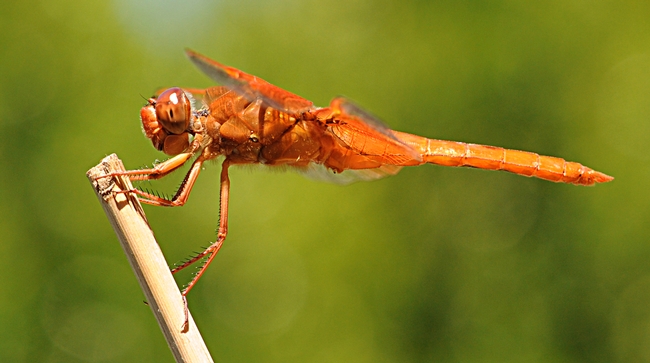
Flame skimmer perched on a bamboo stake. (Photo by Kathy Keatley Garvey)
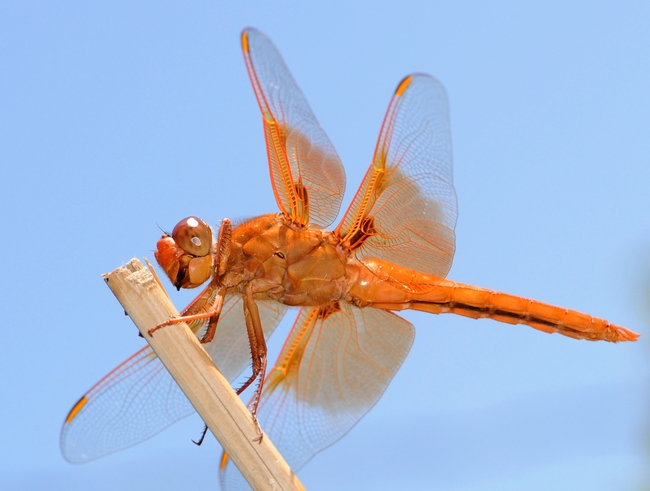
Flame skimmer outlined against the sky. (Photo by Kathy Keatley Garvey)
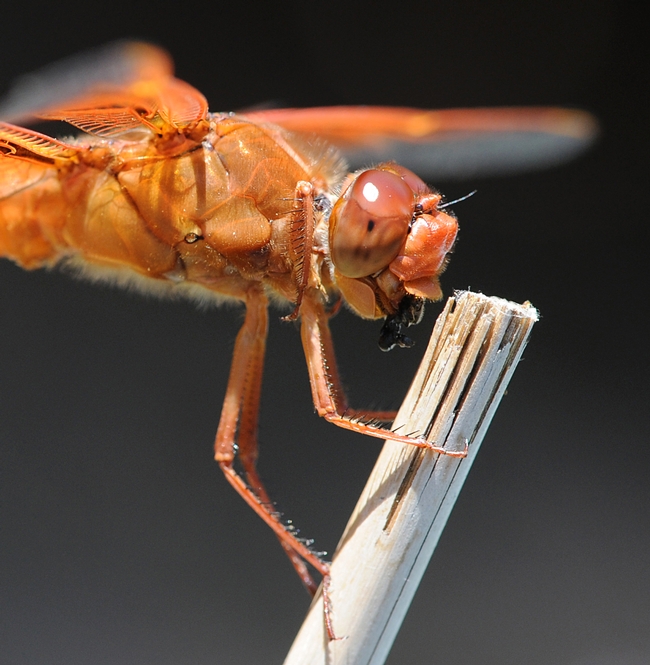
Close-up of flamer skimmer with native bee in his mouth. (Photo by Kathy Keatley Garvey)
Redding newspaper article features new Shasta CD
The Redding Record Searchlight ran a story last week introducing Shasta County residents to their new UC Cooperative Extension director, Larry Forero. Forero replaces Gary Nakamura, who retired in June after 27 years as a forestry specialist - the last four he also served as county director.
The story noted that Forero, 50, has been the UCCE livestock/natural resources advisor in Shasta County for 20 years and will continue in that role in addition to his county director duties. Forero grew up in Weaverville and earned a bachelor's degree in agriculture from Chico State University, a master's degree in range science from Colorado State University and a doctorate in wildland resource science from UC Berkeley.
Forero told reporter Laura Christman that he isn't planning big changes for the local Cooperative Extension service. He expects his biggest challenge to be the tough economic times.
"Like every government entity at this instant, we are trying to figure out what the state budget is and how that is going to play back out in the counties," Forero was quoted in the story.
There are three advisers — livestock/natural resources, nutrition/family/consumer science and crop science — serving Shasta and Trinity counties. Nakamura's forestry specialist position is not expected to be refilled.
With a smaller staff, Cooperative Extension has had to change its approach, Forero said.
"We are doing a lot of webinars and online workshops to compensate for reduced support for face-to-face workshops and field meetings," he was quoted.
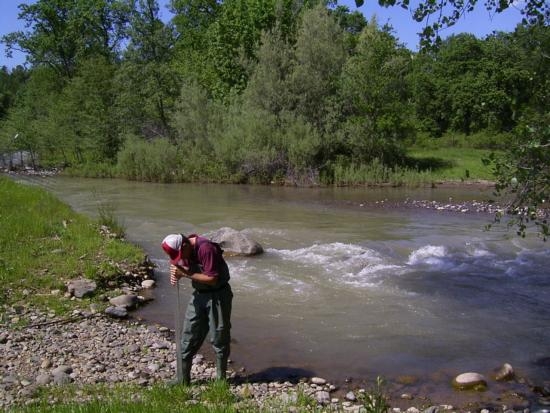
Larry Forero checks water transparency of Cow Creek. Photo by Lisa Thompson.
Bugs Rule at the California State Fair
If you head over to the California State Fair, which opened July 14 and continues through July 31, be sure to check out the Insect Pavilion at "The...
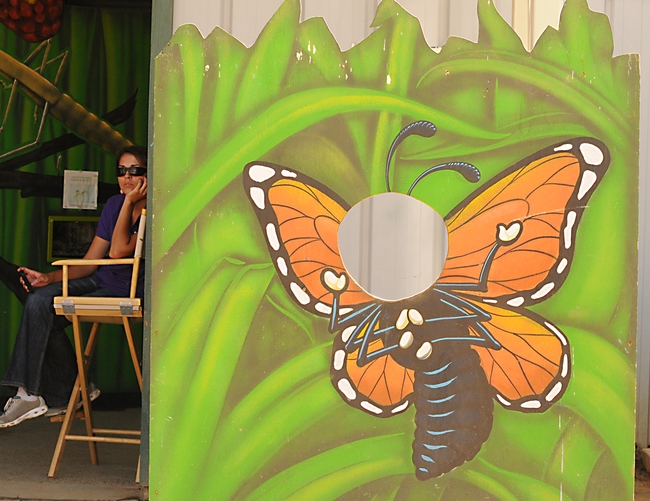
Monarch butterfly cutout in front of the Insect Pavilion at the Caifornia State Fair. (Photo by Kathy Keatley Garvey)
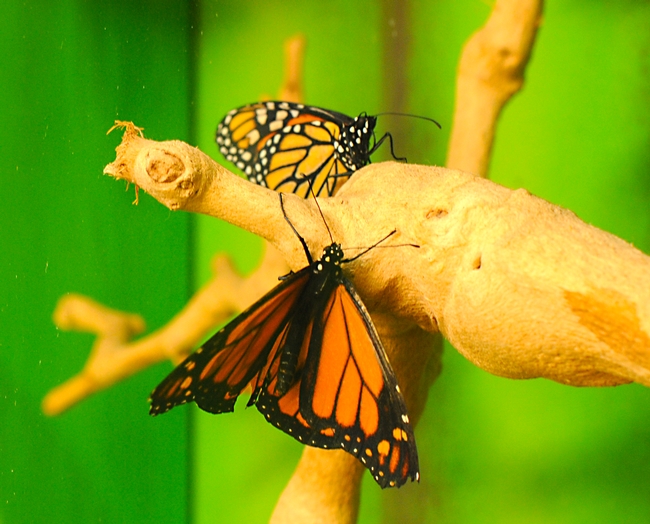
Colorful monarch butterflies are in sharp contrast to the painted cutout (above). (Photo by Kathy Keatley Garvey)
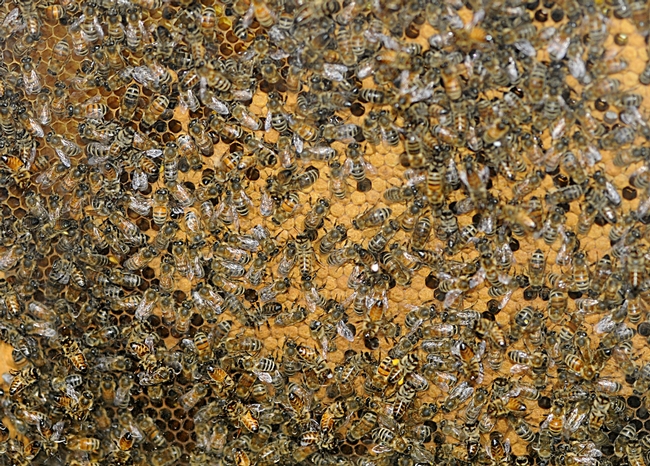
Close-up of bee observation hive in the Insect Pavilion. (Photo by Kathy Keatley Garvey)


